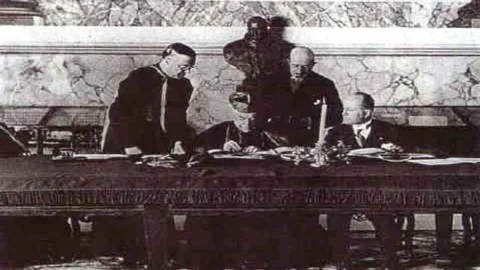95 years ago, on February 11, 1929, they came the Lateran Pacts signed which put an end to a long dispute between the Italian State (the then Kingdom of Italy) and the Santa Thirst. The agreement, composed of three documents, a treaty, a convention and a concordat (the latter revised in 1984), marked the end of the so-called "Roman Problem" and established a new relationship between the Italian State and the Catholic Church, resuming relations interrupted in 1870 with the unification of Italy. Also established Vatican City as an independent state.
The Lateran pacts are referred to in article 7 of the Italian Constitution:
"The State and the Catholic Church are, each in their own order, independent and sovereign. Their relationships are regulated by the Lateran Pacts. The modifications to the Pacts, accepted by the two parties, do not require a constitutional revision procedure."
The Roman question
La Roman question it had its roots in 1870, when Italian troops, led by Vittorio Emanuele II, entered Rome and declared it the capital of the Kingdom of Italy. This event put an end to the temporal power of the Popes, who had governed the Papal State for centuries. The Church, led by Pope Pius IX, refused to recognize the new Italian state and declared its imprisonment in the Vatican.
Although Italy had unilaterally delineated relations with the Church in 1871 with the law of Guarantees, these provisions were never recognized by subsequent popes.
For decades, the Roman question remained a source of tension between the Church and the Italian state. The Holy See refused to recognize the authority of the Italian state over Rome and pursued a policy of non expedit, prohibiting Italian Catholics from actively participating in the politics of the new state.
Over the following decades, the idea emerged that an independent territory would guarantee the Pope freedom of action. In the context of Pope Pius
The content of the Lateran Pacts
After years of negotiations, the Italian government led by Benito Mussolini and Pope Pius signed, February 11, 1929, from Peter Gasparri for the Holy See e by the Duce for the Kingdom of Italy.
The Lateran Pacts consisted of three main documents:
- Lateran Treaty: This established the terms of Vatican sovereignty over an independent state of 44 hectares, known as Vatican City. In exchange, the Holy See recognized Italy as a sovereign state and declared an end to the Pope's state of imprisonment.
- Financial Agreement: attached to the treaty was the financial agreement. This provided financial compensation of 750 million lire to the then Pope Pius XI for the loss of the Papal States in 1870. This amount included both a cash payment and the issuance of government bonds.
Art. 1: “Italy undertakes to pay, upon exchange of the ratifications of the Treaty, to the Holy See the sum of 750.000.000 Italian lire (seven hundred and fifty million) and to simultaneously deliver to the same 5% Italian Consolidated Bearer (with the coupon expiring on 30 June pv) of the nominal value of Italian lire 1.000.000.000 (one billion)"
- Concordat: this defined the civil and religious relations in Italy between the Church and the Government, replacing the previous relationship regulated by the Guarantees Law. A significant feature of the Concordat was respect for the independence of the Pope, exemplified by the non-mandatory oath of allegiance to the Italian government for the Cardinal Vicar of Rome, the Pope's representative. The Italian government agreed to conform the laws on marriage and divorce to those of the Catholic Church and to exempt the clergy from military service. The Pacts ensured Catholicism's status as the state religion in Italy, with significant implications for the public school system, such as compulsory teaching of the Catholic religion. Furthermore, the Concordat recognized the sacred character of the city of Rome, as the episcopal seat of the Pope.
In 1948 the Covenants were recognized constitutionally in article 7. Any changes to the Covenants must take place by mutual agreement between the State and the Holy See, without requiring a constitutional revision procedure.
The revision of the 1984 concordat
The Concordat, which had been contested by lay people and radicals because in some aspects it was considered too unbalanced in favor of the Vatican, was then revised in 1984 mainly to remove the clause regarding the state religion of the Catholic Church in Italy. This revision, signed at Villa Madama on 18 February, saw the participation of Prime Minister Bettino Craxi for the Italian State and Cardinal Agostino Casaroli for the Holy See.
After the abolition of the congruity allowance, a monthly loan guaranteed by the State to parish priests, which remained in force from the unification of Italy to 1986, the question of the new financing of the Church by the Republic. The new Concordat established the tax exemption of offers and the introduction of8 × 1000, which consisted in the distribution of a portion of the IRPEF to the State or to religious denominations based on the choices expressed by taxpayers in their tax returns. Ratified by Italy in 1985, it entered into force in June of the same year.
Il distribution mechanism of 8x1000 was designed in a non-intuitive way to favor the Catholic Church, exploiting the ignorance and laziness of taxpayers. The choice of the recipient of the contribution is not mandatory and many Italians mistakenly believe that by leaving the box empty, the 8x1000 automatically goes to the State, but this is not true.
The reason is simple: the contributions of taxpayers who do not fill in the box are divided in proportion to the choices made by those who indicate a beneficiary. This system creates a significant distortion, since more than half of Italians do not specify which institution they wish to finance, while the minority that does, in 8 out of 10 cases, chooses the Catholic Church.
As a result, 80% of the 8x1000 of the unspecified ends up in the coffers of the Catholic Church, often without citizens being aware of it.
Thanks to this mechanism, the Holy See receives approximately one billion euros a year from the Italian State. If, however, the Catholic Church only received funds from those who indicated it as a beneficiary, the flow of money would be reduced by more than half.
The Court of Auditors denounced the lack of transparency in disbursements and the waste of resources by the State, which seems to show disinterest in its share of responsibility. Politics has so far ignored this problem.





